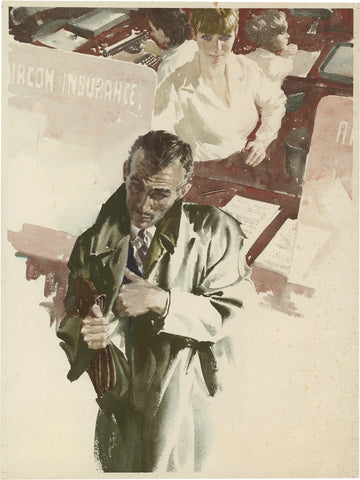Walter Wyles was born in Canterbury, Kent in 1925, to a British father and Spanish mother. At the age of fourteen he was awarded a full scholarship to the Sidney Cooper Art School in Canterbury. He attended the school for only four months, when World War II broke out and instead began work as a book binder and a junior draughtsman for two aircraft manufacturing companies. He went on to work for a London display company, serving as a part-time Air Raid Warden. During this period he attended art classes in his spare time at a school off Fleet Street.
After the war, he worked as a fashion illustrator for trade publication such as Tailor & Cutter, Man & His Clothes and The Draper’s Record. He was first commissioned as a major magazine illustrator by Woman magazine whose editors, Mary Grieve and Tiny Watts, were very encouraging of Wyles’ work and continued to commission him throughout his career. At this time women’s magazines were booming and a magazine like Woman sold three and a half million copies each week.
Encouraged by increasingly radical art directors, Wyles’ style continued to develop and push boundaries. During the 1960s, Wyles’ work evolved from standard realism to a style more reflective of other influences notably American illustrators who incorporated more high contrast colours, Japanese woodcuts, Old Masters (Series done for Woman in 1961) and science fiction.
Partly as a result of his early experience as a technical fashion illustrator, Wyles was known for exceptional portraits of women. These portraits show an artistic sensibility and fascination with the human form that captures a mood well beyond technical drawing. For his book cover portraits, Wyles was known for using “real women” rather than fashion models. While this often suited clients, as professional models were expensive to hire, for Wyles this was a creative preference for life drawing over working from photographs.
As with all the illustrators most in demand during the ‘60s, Wyles’ work afforded him an impressive lifestyle. He was able to indulge his passion for classic cars, acquired a yacht, a stylish West End apartment and other trappings of success. In 1964, Wyles and his wife bought a house in Kent, returning to the region in which he grew up. He has had an extraordinarily long, productive and sustained career and continues to paint every day and still works on portrait commissions.
Walter died in April 2017. He is survived by his wife Maggie and two sons Glyn and Nick.






